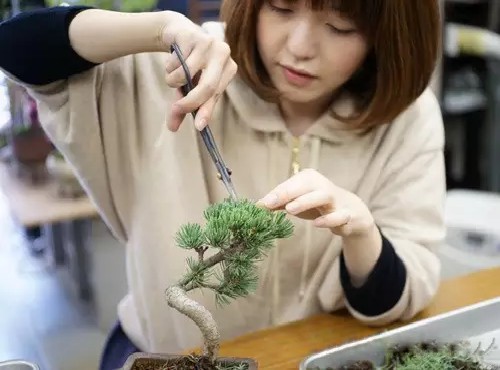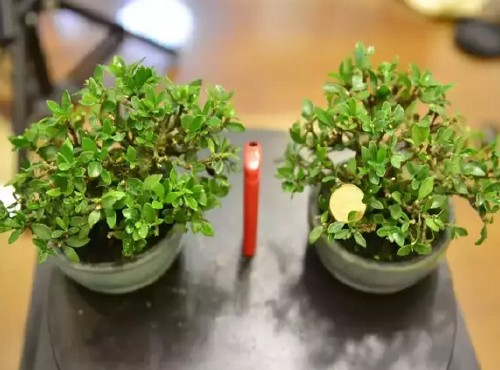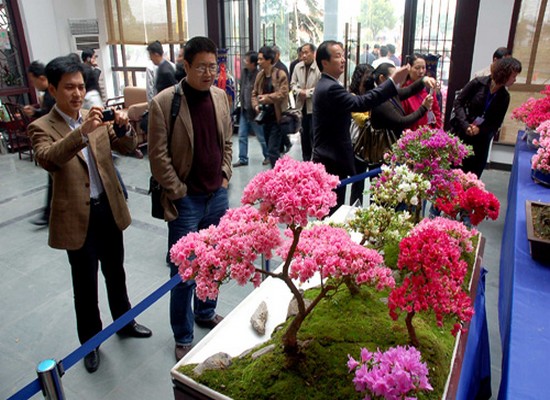Pruning method of bonsai in sketches
Bonsai pruning is synonymous with the means of making potted trees, although there are still techniques such as flat binding, pulling, traction, carving, grafting and so on, but it is often agreed to be attributed to "pruning". As the main means of bonsai modeling, it not only integrates relevant techniques, but also contains modeling ideas and creative ideas in "scissors". However, think about this a little bit, the important thing is not the pruning itself, but the modeling rules and related common sense embodied by pruning. Because the pruning itself is nothing more than a 45-degree oblique cut, and the section is required to be flat, clean, skillful, etc., as for rough cutting, fine cutting, fine cutting and so on are only different links in the process of basin tree shape pruning. Therefore, the important thing is to cut outside, that is, "how to prune", "delete" and "stay" and other issues, in view of this, experience, there are two, that is, the plant characteristics and aesthetic characteristics of potted trees.

I. Plant characteristics
Plant characteristics are rational and scientific, do not cross over without authorization, different tree species have different characteristics, and the same tree species are different in different regions, temperature and climate, so there are different pruning methods.
1. Unbalanced pruning. That is, it is not a comprehensive pruning, but a local pruning method that is adopted according to the physiological characteristics of the plant, which is beneficial to the healthy growth of branches and to avoid morbid branch shrinkage, including pruning and branch control.
(1) drawing and cutting. In general, when the new billet survives and stays, the excess branches are cut off without reservation, so that the remaining branches can be obtained.
Ventilation and light at the same time, the supply of concentrated nutrients, branches grow fast and strong, shorten the branch support storage time.
(2) controlling branches. In general, in the initial process of branch support storage and modeling production, due to the positive orientation of plants, apical advantages and other reasons, the growth of branches is often out of sync, and the growth speed is fast and slow. In order to make the weak branches develop and grow as soon as possible, some branches with relatively high proportion must be controlled consciously (cutting off most of the branches or side branches), so that the weak branches can have sufficient light nutrients, so as not to affect the pruning of the whole shape due to the immaturity of individual branches. The function of branch control can also be extended to the refinement and concrete modeling of branch receptacle, which is an effective method to adjust the balanced growth of branch receptacle.
2. Balanced pruning. That is, omni-directional pruning, usually before the pot tree is close to taking shape or participating in the exhibition. At this time, it can be comprehensively trimmed and carried out repeatedly, which can not only make the branches mature and plump, but also keep the tree beautiful.
3. Pruning with leaves. With leaves refers to the branches left by pruning must be with leaves, especially to make sure that the bud position leaving a branch must be with leaves, if there are no leaves, the branches can be cut down to the leafy place (two or three pieces). By forcing the bud, wait for the remaining bud to sprout normally, and then re-cut it in place. This is due to the physiological characteristics of the plant and the transfusion of the tree sap it contains. Therefore, if unbalanced pruning, it is necessary to take leaves, otherwise, it may cause shearing and even withered branches (without leaf pruning, generally comprehensive pruning, or comprehensive leaf pruning, as well as winter pruning of deciduous miscellaneous trees).
4. Reserve pruning. According to the different callus ability and special conditions of tree species, in the process of pruning, it is mainly reserved for prevention, that is, it is not in place once, cut twice, leaving one or two more bud positions, waiting for the remaining buds to become twigs strong, or the reserved nodes are naturally withered and then pruned, such as Finch plum, Pushu, etc. this method is often used in pruning. In the specific implementation, the coarse branch wound is large, easy to atrophy, can be reserved longer, the twig atrophy degree is relatively small, short can be retained.
Second, aesthetic characteristics
Pruning is a means, how to prune is more in line with the law of beauty, it is worth exploring, of course, everyone's character, temperament, self-cultivation are different, the aesthetic orientation can not be unified, but bonsai as an art category, it has its own corresponding and common rules, it is necessary to grasp the application of the proportion, angle and outline aesthetic factors covered by the deletion and retention of branches in its structure in the overall pruning.
1. Keep the branch to fix the support and delete the superfluous branch. Pile blank cultivation, branches and buds, uncertain deletion, difficult to cut, or creative ideas are biased and guided.
Although the wrong shearing can be adjusted, it can prolong the time of storing branches and its modeling, because the fixed support is the premise of the frame, according to the individual characteristics of the pile, such as straight, oblique, curved, lying, hanging, facing water and so on, it should be integrated into the author's conception image, stay branches and stay, delete all miscellaneous branches and buds, concentrate nutrients, and preserve the remaining branches, so as to enter the pruning and production process as soon as possible.
2. Coordinated proportion and exquisite pruning. Branches support crazy growth, when to trim, where to cut, there should be a thickness comparison, which runs through the basin tree modeling from beginning to end, related to the various parts of the basin tree structure. In the meantime, the ratio of branches to stems, the ratio of branches to each other, and the comparison of steps between the main and secondary veins of branches, and so on, must be clear before cutting, and they are intended to be cut before pruning, so that the branches can be cut up and down properly.
3. Angle orientation, precise and fine cutting. The angle of the branch bud, the divergent direction of the branch, and the staggering among each other reflect that the branch support stretches and rotates up and down in space, and the angle is improperly chosen, although it can be made up for by flat binding, but it is not as good as the natural state after all, so when choosing the angle of the bud point, we should not only pay attention to one, but not investigate the other, that is, we should not only be clear about the direction of the branch, the spatial state, and the interrelationship with other branch supports, but also "advance" the idea. Have some judgment and avoid mechanical, rigid and stereotyped.
4. Profile control, integrated pruning. The outline shows the overall state of the pot tree, that is, the so-called triangle or unequal triangle composition and so on. Here, the length of individual branches should be subordinated to the whole, grasp the point, line and melt into the whole surface. Overall observation, local pruning, comprehensive adjustment, at this time the pot tree basically tends to be plump and mature, belongs to the styling production stage, its focus lies in the length of the branch support opening and closing and the overall relationship of the outer porch.
In short, scissors are visual in operation, how to cut is latent in thinking, and the combination of the two is a complete pruning. In fact, how to cut apart from grasping the characteristics of plants belongs to the category of artistic aesthetics to a large extent, and it is by no means a concealable word. As far as the above is concerned, it is only a few links that should be involved in pruning.
Time: 2019-06-12 Click:
- Prev

Gardenia bonsai leaf control pruning method
Gardenia is quite easy to use bonsai species, resistant to pruning, all-day sunshine, shading is not easy to have big problems (just not growing well), waterlogging, flood and fat, dry point is no harm. To play Japanese sketches, players generally choose two reasons, first, the variety is fierce, aiming at the variety to play. Second,
- Next

Artificial propagation and cultivation method of rhododendron bonsai
Rhododendron is one of the top ten famous flowers in China, which is widely distributed in our country and is a famous ornamental object. Bai Juyi, a poet of the Tang Dynasty, once praised the azaleas as colorless as peaches and plums, so that hibiscus is not a flower. As early as the middle of the 16th century, people began to explore the species and habits of rhododendron and began to domesticate and cultivate them.
Related
- Fuxing push coffee new agricultural production and marketing class: lack of small-scale processing plants
- Jujube rice field leisure farm deep ploughing Yilan for five years to create a space for organic food and play
- Nongyu Farm-A trial of organic papaya for brave women with advanced technology
- Four points for attention in the prevention and control of diseases and insect pests of edible fungi
- How to add nutrient solution to Edible Fungi
- Is there any good way to control edible fungus mites?
- Open Inoculation Technology of Edible Fungi
- Is there any clever way to use fertilizer for edible fungus in winter?
- What agents are used to kill the pathogens of edible fungi in the mushroom shed?
- Rapid drying of Edible Fungi

